|
A Brief History of the NPOI
.
2009
2008
2007
2006
2005
2004
2003
2002
2001
2000
1999
1998
1997
1996
1994
1993
1992
1991
1989
----
| March: |
Positive fringe detection of a geostationary
satellite on 2 nights.
|
| January: |
Position precisions of 16 milliarcseconds demonstrated for
58 stars towards the first USNO-NPOI Astrometric Catalog (UNAC).
|
| October: |
First orbit of close pair
in Algol triple star system from optical interferometry;
orbit of outer star corrected.
>>>(Figure from Bob Z here)<<<<<
/--> |
| April: |
Record nightly number of multi-baseline observations: 282.
|
| March: |
Record monthly number of observations: 4,343.
|
| February: |
Tentative fringe detection of a geostationary satellite.
New orbit published for the O-star binary system 1 Orionis C
(Patience et al. 2008).
|
| November: |
Routine observations commence towards
the first “100-star” installment of the NPOI wide-angle astrometric
star catalog (UNAC).
|
| March: |
White paper on potential science using the NPOI,
as enhanced with four 1.8m “outrigger” telescopes.
|
| October: |
Simultaneous imaging observations of
Algol conducted by NPOI (optical) and Very Long Baseline
Interferometry (radio), with supporting spectroscopic observations
at Lowell Observatory.
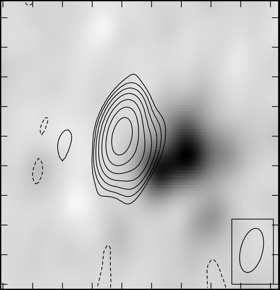
The contours in this image show the close binary in Algol resolved with the NPOI.
The grey-scale is a 4cm radio image made from data obtained with the Very Large Array
of the National Radio Astronomy Observatory. The shape of the grey-scale represents the
changing radio emission as the radio emitting secondary star moves along its orbit
during the period of observation. The oval in the lower right represents the resolution
of the NPOI array during the observation.
|
| April: |
Results of NPOI observations of Vega,
published in Nature
(Peterson et al. 2006),
show this to be a rapidly rotating star (93 percent breakup velocity)
seen nearly pole-on.
|
| January: |
C-term metrology system operational –
greatly improves precision of wide-angle astrometry.
|
| March: |
Begin NPOI survey observations of bright stars.
|
| June: |
First paper on NPOI observations of the disks
of Be stars utilizing self-calibration of the H-alpha channel
(Tycner et al. 2003).
|
| May: |
First images of triple star system Eta Virginis,
based on 6-station observations, published
(Hummel et at. 2003).
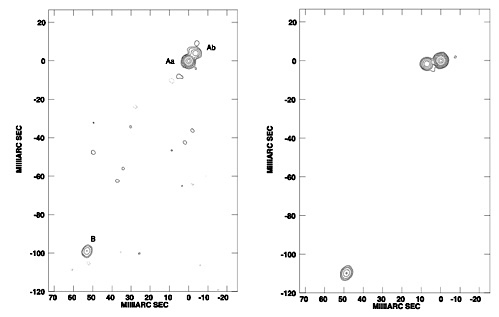
Images of Eta Vir on 2002 Feb 15 (left) and 2002 May 19 (right).
|
| January: |
First routine co-phased 6-station observations
– world first.
|
| May: |
All Long Delay Line (LDL) vacuum pipes
and stations installed.
Begin first observations of Be stars.
|
| March: |
Orbit for the close binary
star Omicron Leonis published
(Hummel et al. 2001).
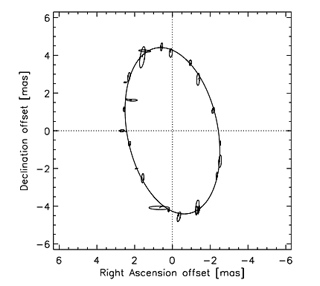
|
| December: |
Sixth siderostat station completed.
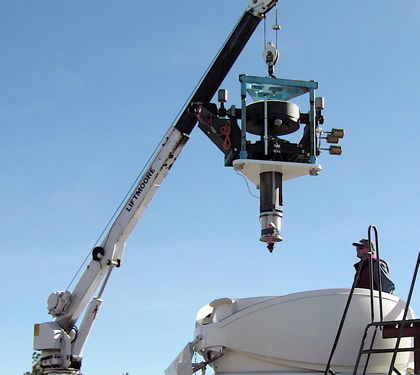
|
| September: |
NPOI’s resolution of a 4th magnitude companion
to the bright (2nd magnitude) star Zeta Orionis A is published
(Hummel et al. 2000).
|
| April: |
Upgrades of beam combiner to 6-beam combination completed.
Avalanche Photodiode (APD) fringe detectors in new vacuum housings.
Last Fast Delay Line (FDL) installed.
|
| December: |
Angular diameters for 50 stars, with
precisions of ~1% published
(Nordgren et al. 1999)
|
| October: |
Start expansion of baseline metrology to
last (north) astrometric station. The system at each astrometric hut
consists of laser interferometers that measure the position of
the siderostat relative to the bedrock under each hut.
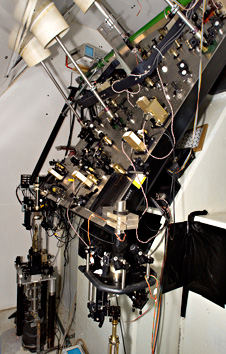
|
| November: |
Assembly work begins on vacuum and
optical systems for the outer array. The photo shows the installation of the
vacuum cover over the feed optics at one of the stations on the east arm of the array
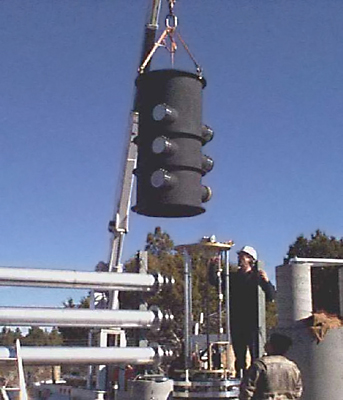
|
| July: |
Infrared beam-combiner optics installed; first infrared fringes recorded.
|
| June: |
First two imaging siderostats installed on the array.
|
| March: |
Limb-darkened angular diameters published
(Hajian et al. 1998).
|
| May: |
Concrete work begun for outer part of the array.
|
| March: |
First three-baseline observations with closure phase.
The illustration (below) shows that closure phase data may be used to produce real images,
here of the binary star Mizar A. The separation between the two stars is about 6.5 milliarcseconds,
about eight times the resolution of the Hubble Space Telescope.
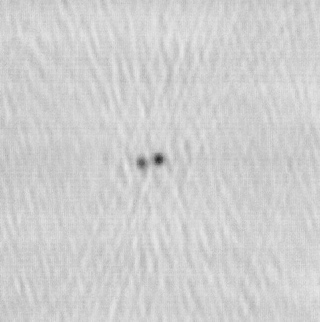
|
| October: |
First single-baseline stellar fringe observations.
|
| June: |
First astrometric telescopes and visible-light beam
combiner optics installed.
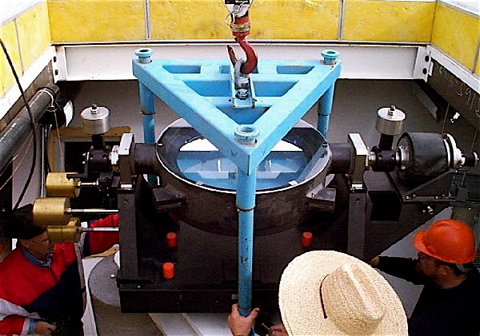
|
| January: |
After approximately a year and a half,
the initial phase of construction is completed. This includes the concrete
piers to hold the siderostats, beam compressors, elevator cans and
center feed cans for the imaging and astrometric arrays, the control
and lab buildings, and the astrometric huts.
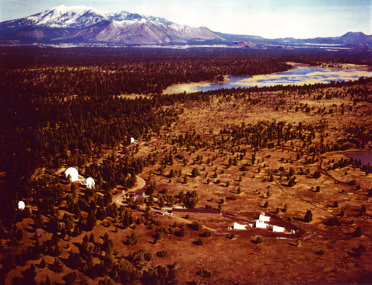
|
| July: |
Control and lab buildings completed, inner array construction begins.
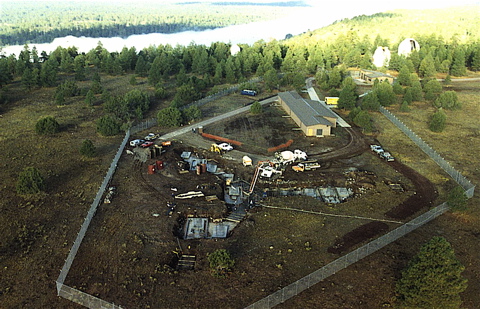
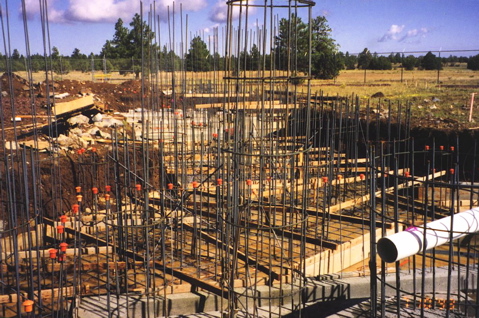
|
| September: |
Construction begins on Anderson Mesa.
|
| August: |
Culmination of the NEPA process with the issuance of the Decision Notice.
|
| January: |
NEPA (National Environmental Policy Act) process initiated.
|
| September: |
USNO, NRL, and Lowell Observatory sign a contract
to build the NPOI on Lowell’s dark sky site at Anderson Mesa, southeast of Flagstaff,
Arizona. Lowell Observatory provides the development site. During the following 12
months, Lowell works with the Forest Service, obtaining the necessary construction permits.
Also, sub-contracts were let to local construction firms during this period.
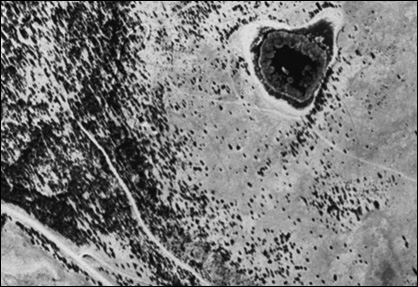
An aerial view of the array site on Anderson Mesa before construction began.
( Place cursor on the image to see the array location.)
|
| July: |
Work commences on the project.
Funding for what is to become the NPOI is initiated by the Oceanographer
of the Navy and the Office of Naval Research. Design work begins on all
phases of the project. Fabrication of major components, including the
siderostats and the internal components of the elevator and array feed
cans and the fast delay lines begins in the USNO instrument shop.
|
NPOI Calendar Year Observing Statistics:
Multi-Baseline Scan Totals from Monthly Archival Reports
| 1997 |
|
5,978 |
| 1998 |
|
3,886 |
| 1999 |
|
1,908 |
| 2000 |
|
3,158 |
| 2001 |
|
5,405 |
| 2002 |
|
9,602 |
| 2003 |
|
7,680 |
| 2004 |
|
21,437 |
| 2005 |
|
13,879 |
| 2006 |
|
20,803 |
| 2007 |
|
22,530 |
| 2008 |
|
23,128 |
|
|
|
| GRAND TOTAL |
|
139,394 |
|